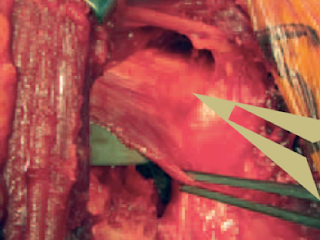These authors investigated 286 shoulders after a reverse total shoulder. Indications for surgery included rotator cuff tear arthropathy, osteoarthritis with rotator cuff deficiency, irreparable rotator cuff tear, or proximal humerus fracture. Complications were documented in 16 (5.6%) of the 286 subjects in the first 12 months postoperatively. including 1 intraoperative humerus greater tuberosity fracture, 8 postoperative periprosthetic humerus fractures, 2 acromion fractures, 2 dislocations, 2 cases of glenoid baseplate aseptic loosening, and 1 infection.
The cases were stratified into 2 groups: group I included shoulders that had achieved at least 145 of active forward elevation 12 months postoperatively (90th percentile of active forward elevation, 29 shoulders) and group II for shoulders that never achieved at least 90 of active forward elevation 12 months postoperatively (10th percentile of active forward elevation, 28 shoulders).
The only independent predictor of improved postoperative forward elevation was preoperative active forward elevation: shoulders in group I had 106±30 degrees of active elevation preoperatively whereas shoulders in group II had only 56±27 degrees of preoperative active elevation (<.0001).
Comment: In this series 29 patients were able to raise their arm above 90 degrees at a year after reverse total shoulder (Group I), while 28 (almost half) were not (Group II).
The usual rationale for a reverse total shoulder is pseudoparalysis, commonly defined as the inability to raise the arm actively above the horizontal (active elevation < 90 degrees). The average patient in group I had more than 90 degrees of active elevation before surgery (i.e. did not have pseudo paralysis). By contrast the patients in Group II appeared to have pseudo paralysis that was not resolved by the reverse total shoulder. The authors were unable to find an explanation for the failure of these patients to regain active elevation, i.e. to reverse their pseudo paralysis.
By contrast to these results, our experience is that a well done reverse total shoulder is very effective in restoring active elevation to those with pseudo paralysis. For patients with cuff tear athropathy and retained active elevation (i.e. no pseudo paralysis), we often use the cuff tear arthropathy prosthesis because of its low complication rate and the need for minimal activity restrictions after surgery. See below
Clinical effectiveness and safety of the extended humeral head arthroplasty for selected patients with rotator cuff tear arthropathy
Cuff tear arthropathy is a type of shoulder arthritis in which both rotator cuff and the cartilage normally covering the joint are both deficient.
When the patient is unable to elevate the arm above the horizontal, cuff tear arthropathy is often treated using a reverse total shoulder.
However, when active elevation of the arm is present, a humeral hemiarthroplasty with an extended humeral head (the CTA arthroplasty) can provide a safe, effective and less invasive alternative. In this procedure the resurfaced humeral head articulates with the undersurface of the intact coracoacromial arch.
This surgical procedure requires matching of the diameter of curvature of the native humeral head
And preserving the stabilizing tissue covering the anterior aspect of the humeral head.
Appropriate sizing of the humeral head prosthesis can re-tension the deltoid.
This procedure cannot be used when the shoulder has been destabilized by a prior acromioplasty
More about this technique can be seen in this youtube (link).
Here is an example of a shoulder with cuff tear arthropathy before surgery. In spite of the destruction of the joint surface, the patient was able to actively elevate her arm.
Here is an example of a shoulder with cuff tear arthropathy before surgery. In spite of the destruction of the joint surface, the patient was able to actively elevate her arm.
She elected to have a CTA arthroplasty. At surgery she had complete and irreparable failure of her supraspinatus or infraspinatus.
Here is her shoulder shoulder nine years after the CTA arthroplasty, showing remodeling of her coracoacromial arch.
She generously granted permission for us to show her function nine years after surgery.
At an average of 2-years after surgery, there were no complications or revisions. Specifically the complications that have been associated with a reverse total shoulder were avoided: no component dissociations, no baseplate failures, and no dislocations.
The Simple Shoulder Test score improved from a median of 3.0 to 8.0 (P < .001). The median percentage of maximal possible improvement was 50% (P < .001). The percentage of patients able to perform each of the functions of the Simple Shoulder Test was significantly improved; for example, the ability to sleep comfortably increased from 19% to 71%, and the ability to place a coin on the shelf at shoulder level increased from 38% to 86% (P < .001).
===
We have a new set of shoulder youtubes about the shoulder, check them out at this link.
Be sure to visit "Ream and Run - the state of the art" regarding this radically conservative approach to shoulder arthritis at this link and this link
Use the "Search" box to the right to find other topics of interest to you.
You may be interested in some of our most visited web pages arthritis, total shoulder, ream and run, reverse total shoulder, CTA arthroplasty, and rotator cuff surgery as well as the 'ream and run essentials'











